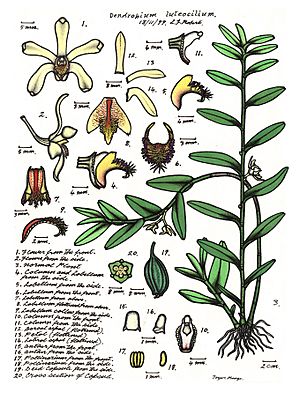Honey orchid facts for kids
Quick facts for kids Honey orchid |
|
|---|---|
 |
|
| Illustration of Dendrobium pruinosum by Lewis Roberts | |
| Scientific classification | |
| Genus: |
Dendrobium
|
| Species: |
pruinosum
|
| Synonyms | |
|
|
The Dendrobium pruinosum, often called the honey orchid, is a special type of orchid. It can grow on other plants, like trees (this is called an epiphyte), or on rocks (this is called a lithophyte). This orchid has flat, yellowish stems and flowers that are cream, dull yellow, or greenish. You can find the honey orchid growing in tropical North Queensland in Australia and in New Guinea.
Contents
What Does the Honey Orchid Look Like?
The honey orchid is a plant that grows on trees or rocks. It has flat, yellowish stems that can be anywhere from 0.3 to 2 metres (about 1 to 6.5 feet) long and 10 to 15 millimetres (about 0.4 to 0.6 inches) wide.
Leaves and Flowers
The leaves grow along the stems. They are yellowish-green and feel leathery. Each leaf is about 80 to 120 millimetres (about 3 to 4.7 inches) long and 40 to 50 millimetres (about 1.6 to 2 inches) wide.
The flowers grow in pairs on the sides of the leafy stems. Each flower is about 17 to 20 millimetres (about 0.7 to 0.8 inches) long and wide. The flowers are usually cream-coloured, yellow, or greenish. A cool fact about these flowers is that they only stay open for a few hours!
Flower Parts
Orchids have unique flower parts:
- The top petal, called the dorsal sepal, is about 20 to 25 millimetres (about 0.8 to 1 inch) long and 6 millimetres (about 0.2 inches) wide.
- The side petals, called the lateral sepals, are about 14 to 18 millimetres (about 0.6 to 0.7 inches) long and 5 millimetres (about 0.2 inches) wide.
- The main petals are about 13 to 17 millimetres (about 0.5 to 0.7 inches) long and 5 millimetres (about 0.2 inches) wide.
- The labellum is a special lip-shaped petal. It is curved and bright yellow, about 9 millimetres (about 0.4 inches) long and 8 millimetres (about 0.3 inches) wide. It has three rounded parts, called lobes. The middle lobe has a clear patch of yellow hairs in its centre.
The honey orchid can flower at different times throughout the year, not just in one season.
How the Honey Orchid Got Its Name
The scientific name for the honey orchid, Dendrobium pruinosum, was first officially described in 1862. It was named by two scientists, Johannes Elias Teijsmann and Simon Binnendijk.
Meaning of the Name
The second part of its scientific name, pruinosum, comes from a Latin word. It means "frosty," which might refer to the slightly powdery or frosted look of some parts of the plant.
Where the Honey Orchid Lives
The honey orchid likes to grow in warm, wet places like rainforests. It usually prefers sunny and humid spots. You can find it growing on trees and rocks in these areas.
Locations
This orchid lives in lowland forests and lower mountain forests in New Guinea. It also grows on some of the Torres Strait Islands and along the Cape York Peninsula in Australia, from the Iron Range down to Tully.

